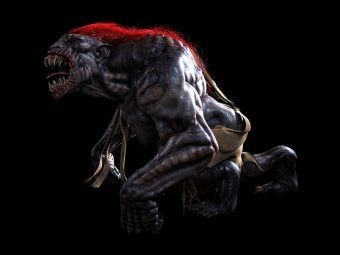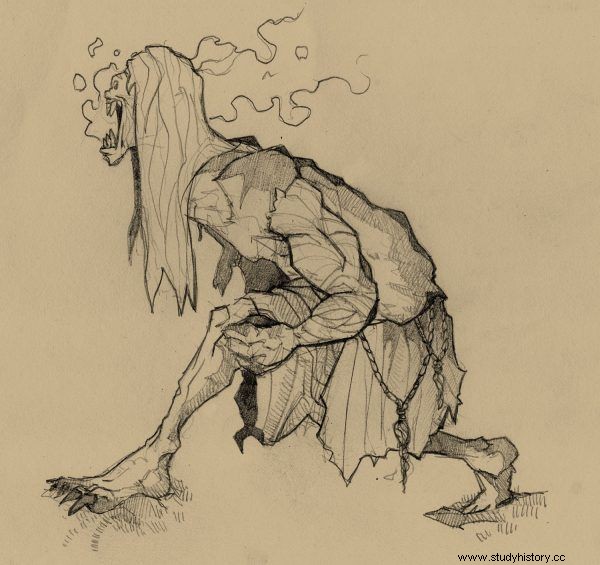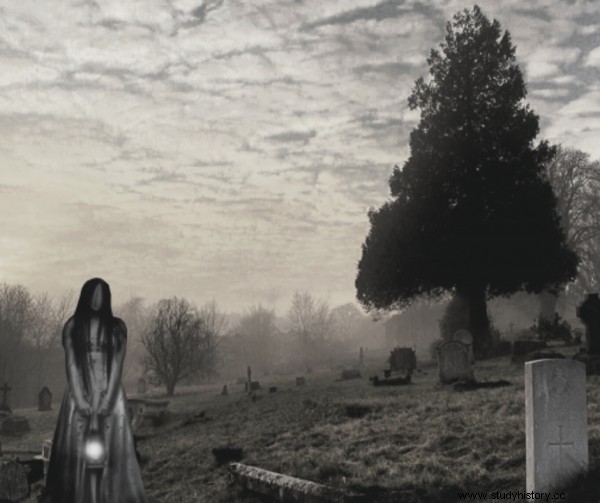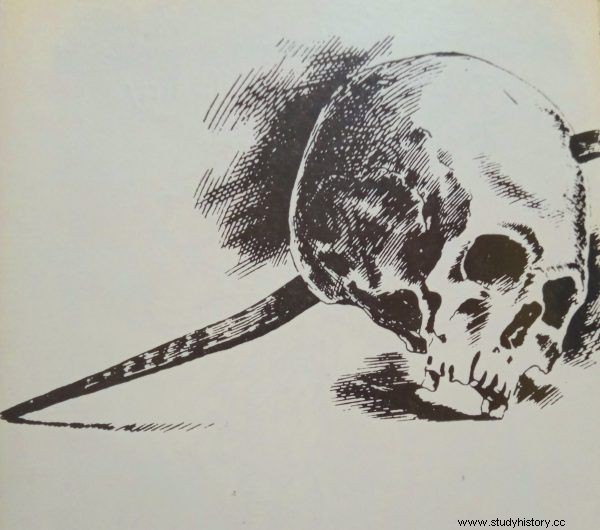One of the many sources of inspiration for Andrzej Sapkowski's story was Slavic demonology. Today it is being rediscovered and it turns out to be an amazing source of inspiration for the creators of not only books, but also games and film productions. Among the multitude of demonic creatures that inhabit the pages of books about The Witcher, and which have their origins in the Slavic folk imagination, one of the most recognizable is the "striga".
Striga or phantom?
The word "striga", the wording of which would suggest a Slavic origin, really came to us from Latin. This name, as the Polish Slavist Alexander Brückner claimed, can be derived directly from the Latin "strix, strigis", which in turn comes from the Greek "strinx". The word meant grave bird, in which the deceased flies from the grave after death and sucks the blood of the living or devours their insides. The striga is therefore a ghost-like character whose name is supposed to be purely Slavic.
Like the phantom, the striga (or - in the male version - striga) is the dead rising from the grave to spread terror among the living . Unstoppable, it entails a whole procession of death. For whoever comes into contact with it usually dies. Phantoms and strigoi can also suck blood from domestic animals or take milk from cows. In folk tales, the images of the striga and the phantom actually blended together. Sometimes people try to distinguish them, but many of their features are the same.

This is how the creators of the game "The Witcher" imagine
People who died a violent death, unbaptized children, suicides, evil or unbelievers could become phantoms or strigoi . However, people who displayed certain unusual traits in their lifetime also had makings of a demon. And so, it was said that people born with teeth, having two rows of teeth, a fused eyebrow, or a birthmark on the back could become a wraith or a striga after death. It has also often been argued that future strigoi were born with two hearts or two souls. While the first soul was baptized, the second was ruled by the unclean powers. Therefore, after death, the baptized soul left the body, and the unbaptized remained in it. Confirmation was sometimes treated as the baptism of the other soul, which freed the victim from the stigma of "ghostly".
There were times, however, that the transformation into a phantom was the result of a spell cast. The author of the 18th-century encyclopedia "New Athens", Benedykt Chmielowski, claimed that the wraiths are the bodies of the dead, revived by witches, as a result of their conclusion of a pact with the devil:
... only a child is born, then, before all the crosses, sprinkling holy water, and most importantly holy baptism, give the child's body to a devil. And although during the Baptism of St. In some words, the devil is driven away, but after death, according to the pactum done with the woman, he becomes interested in the body of that man devoted to himself in his childhood; if this body is not prevented with such exorcism or with what holiness is placed in its mouth, it takes that rotten, smelly, naturally infectious body, and adds to his charter arts that while being in this body and bringing it out of the grave (...) it infects people ....

Artistic vision of a striga
In the short story "The Witcher", which opens the volume "The Last Wish", we are also dealing with a spell. Here, however, the situation is somewhat different. The witcher Geralt has to face the striga into whom the princess has been enchanted. The girl was born from the incestuous relationship between the King of Vizima, Foltest, and his own sister, Adda. According to the news, the quick death of the child and his transformation into a striga were precisely the punishment for this heinous act. However, as it soon turned out, the real cause of the misfortune was the spell cast by a noble, jealous of Adda, with whom he was in love.
What did the striga look like?
Creatures like strigoi or phantoms usually had dark or red skin, thick hair, large head and eyes, large teeth. Usually, they were also much taller than the living. Not infrequently, instead of human feet, they had bird or animal legs, and sparks flew from their bodies. The color red is a common attribute of these creatures - female demons are usually seen in costumes, wreaths or hats of this color. The color of red is naturally associated with the blood that the striga drank, which is why she also had a ruddy complexion.
The striga from "The Witcher" had similar features:after birth, her character aroused fear in the witnesses of this event - as recalled by Velerad, the castellan of Vizima:
Many people did not see what was born, but one midwife jumped out of the tower window and killed herself, and the other got confused and is still rounded to this day. So I guess the bully was not very pretty.
As we learn later, this striga also had a huge height, a disproportionately large head, as well as red eyes and red hair:
is four cubits tall, resembles a barrel of beer, has a mouth from ear to ear, full of teeth like daggers, red eyes and red hair! The paws, clothed like a wildcat's, hang right to the ground!

According to folk beliefs, in cemeteries one could often encounter ghosts - ghosts, strigoi or repentant souls.
In folk imaginations, strigoi or ghosts could also be backless or have black backs. Sometimes they took the form of an animal (a dog, a cat, a wolf, a horse, a ram, or a goat).
Ways to make a striga
The methods of dealing with the striga / striga were the same as the remedies for wraiths. It was necessary to dig up the grave and knock the deceased face down, "to bite the ground", or to pierce his chest with an axenoid pin or a nail . Sometimes it was also advised to find a hole or a slit in the coffin and pour holy water or poppy seeds in it. It was said that the specter would first have to count all the poppy seeds before coming out of the coffin, which he would surely spend the whole night for. However, the poppy seed could also have a different meaning - it was often an offering to the dead. In addition, it had a sleep-inducing effect, so it could also be about putting the demon to sleep finally.
Another way, often described as the most effective, was to cut off the striga or phantom's head and place it between its legs. Then the demon will not be able to find her and thus come out of the tomb. It was also advised to stick sharp tools, such as knives and nails, into the grave. There were times when a mass for the soul of the deceased helped or by putting up a cross next to his house.
However, these actions were not successful for all the deceased leaving the tomb. There were times when other methods had to be used. This was the case in a folk legend played in the short story "The Witcher".
The Striga Princess
The story of the disenchantment of the princess-striga was a common theme in folk tales. The reason for the enchantment was usually the unusual circumstances of the princess's birth, often as a result of late pregnancy or careless wishes of her parents. One of the stories from the Rzeszów region mentions a man who could not wait for his wife to give birth and "impatiently renounced against God's will that God would give him, if only it would be, let it be some". In Roman Zmorski's "Podacje i fairy-tales of the people" by Roman Zmorski, there is also the theme of the parents' incestuous relationship - a princess is born from the king's relationship with his sister (same as with Sapkowski). Other legends mention that the mother or child was cursed, but the reasons and perpetrators are usually unknown. After her death, the princess is not buried in the ground, but in a coffin placed in the church's crypt. The same applies to Foltest's daughter, whom they hide in a sarcophagus in the crypt of the manor house.
At the end of the 19th century, in Maszyce near Krakow, Stanisław Ciszewski recorded a fairy tale about the royal daughter buried in the church. Although the name "striga" was not explicitly mentioned, the story can be treated as a duplication of the same theme. At night, the deceased princess would come out of the coffin and devour the guards who guarded the grave. One time another soldier was sent to her. The latter, however, having previously consulted a certain gray-haired grandfather, hid in the pulpit the first night. There the striga could not find him. The next night his grandfather made him stand by the candlelight, then put on the princess's shirt and lie down in the coffin. He did so too.
[Striga] could not own anyone. Here the hour beats the breast, the hour goes to the coffin, and here it is in the coffin. Asks him, wages, to send; is not coming out. As if he could fly, he was thrown at him with various church decorations. But he is there. This is how he looks here, and this is what Bielsa does (...), until she has become beautiful ladies. And only then I thank him for saving Yom. In the morning she comes, and here is such a beautiful lady standing over her.
Thus, as we learn, the ultimate method of lifting the curse was to lie down in the coffin and prevent the striga from re-entering it before dawn.

Skull pierced with a nail, excavated in 1870
It can be noticed that the Christian accent is strong in folk accounts. Presumably specific places in the church, related to the sacred, protect the hero of the legend from the power of the striga. Of course, we will not find these threads in "The Witcher", but the main scheme of the story has remained the same. Geralt, after a moment of fighting with the striga, enters the sarcophagus in which she was lying and spends the rest of the night there. In the morning, the princess is disenchanted, although maybe not as pretty as in folk tales, because she is said to be "skinny and stupid".
Fear has big eyes
Thus, the said story repeats folk motifs referring to a number of accounts of demonic characters. These stories usually mix pagan and Christian themes. The fear of death and the uncertainty of what is happening to the person "on the other side" combined with the fear of what is different, which in some way disturbs the established order (e.g. incestuous relationships, children born with strange characteristics) created dark ideas about these creatures. Today they are a curiosity and inspiration for novels and films, but in the past they were an inseparable part of the vision of the world.
